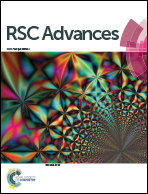5-Ferrocenyl-2,2′-bipyridine ligands: synthesis, palladium(ii) and copper(i) complexes, optical and electrochemical properties†
Abstract
Two ferrocene-appended 2,2′-bipyridine ligands, 5-ferrocenyl-2,2′-bipyridine (Fc-bipy) and 5-ferrocenyl-5′-methyl-2,2′-bipyridine (Fc-bipy-Me) metalloligands were synthesised using palladium(0) catalysed Suzuki–Miyaura cross-coupling reaction. Their coordination chemistry with palladium(II) and copper(I) ions was examined. The molecular structures of several complexes, including [Pd(Fc-bipy-Me)(Cl)2], [Pd(Fc-bipy)(py)2](SbF6)2, [Pd(Fc-bipy)(DMAP)2](SbF6)2, [Pd(Fc-bipy-Me)(DMAP)2](SbF6)2, and [Cu(Fc-bipy)(6,6′-dimesityl-2,2′-bipyridine)](PF6) and [Cu(Fc-bipy-Me)(6,6′-dimesityl-2,2′-bipyridine)](PF6) were determined using X-ray crystallography. 1H and 13C NMR spectra and high resolution electrospray mass spectrometry (HR-ES-MS) experiments confirmed that the majority of the complexes are stable in solution. The exceptions were [Pd(Fc-bipy)(DMAP)2](SbF6)2 and [Pd(Fc-bipy-Me)(DMAP)2](SbF6)2 which were found to disproportionate to give equilibrium mixtures containing [Pd(Fc-bipy)2](SbF6)2 and [Pd(DMAP)4](SbF6)2. The optical absorption and electrochemical properties of these complexes were compared to those of the parent ligands. The 5-ferrocenyl-2,2′-bipyridine ligands are yellow/orange in colour with the expected weak d–d transition found at ∼450 nm. The absorption bands of the palladium(II) and copper(I) complexes are red-shifted relative to the free ligands and show enhanced molar absorptivity. The complexes all display strong MLCT absorptions in the visible spectrum, the palladium(II) compounds are deep purple (λmax = ∼540–560 nm), while the copper(I) complexes are red-brown (λmax = ∼470 nm). Electrochemical investigations showed that all the compounds displayed the expected chemically reversible one-electron oxidation of the ferrocenyl group. The reduction potential of the redox-active ferrocene unit was anodically shifted, relative to the free ligand, upon complexation to the metal ions. The copper(I) complexes displayed an additional reversible oxidation wave that was assigned as a Cu(II)/Cu(I) redox process.


 Please wait while we load your content...
Please wait while we load your content...